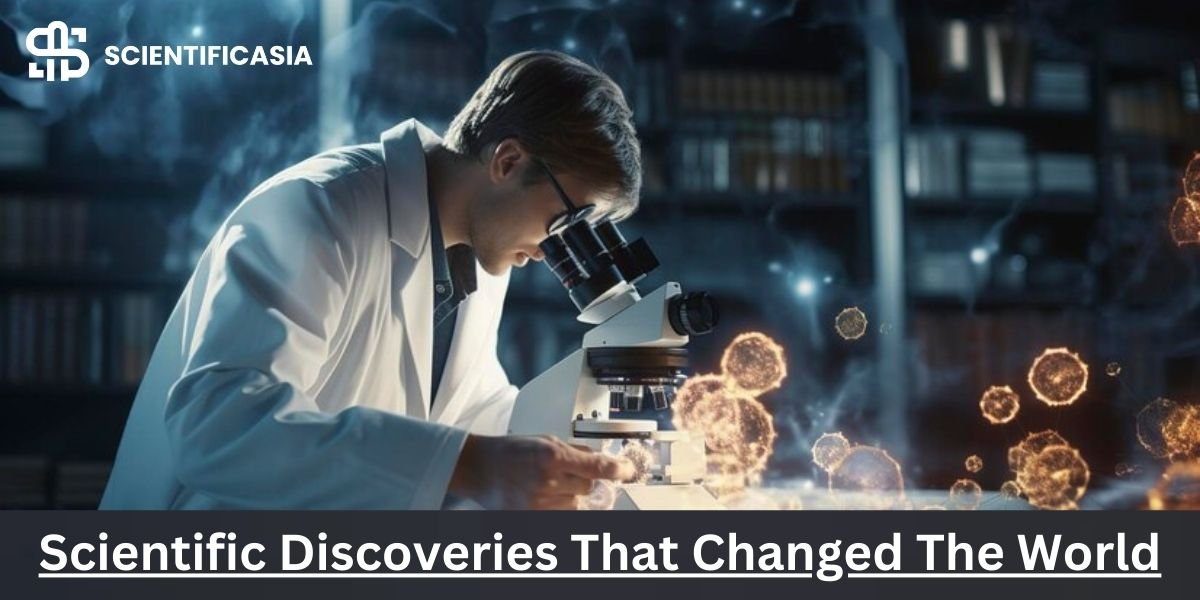While every scientific discoveries is remarkable, some truly transform the field. To express our deep appreciation for science—as if we could love it more—we’ve gathered insights from our discussions and interviews within the life science communities to highlight the findings you consider most impactful. Among the groundbreaking discoveries that have forever altered the course of human civilization are DNA, gravity, germ theory, and many others. These include CRISPR, genome editing, and penicillin.
Here is a list of the most significant scientific discoveries ever made, presented in no particular order, with a focus on their impact on the world.
The early use of fire by our ancestors to cook food and stay warm laid the foundation for the development of early communities and fueled the rise of civilization. Fire’s role in shaping metals for construction and weaponry also led to countless breakthroughs and discoveries. We’ve spotlighted several key scientific milestones that have reshaped the world, even though many advancements have shaped humanity over time.
Resource: TED-Ed
DNA
The discovery of DNA changed how we understand life and how we see the world, though it didn’t change the world itself. Although the term ‘DNA’ became popular in the 20th century, it was first discovered in the 19th century.
What is DNA?
DNA is the molecule that carries the genetic information of all living organisms. It is the key component of chromosomes in the cell nuclei of complex organisms, playing a crucial role in transferring traits from parents to children.
Who Discovered DNA?
Many believe that scientists Francis Crick and James Watson discovered DNA in the 1950s, but the story goes back much further. In 1869, Swiss physician Friedrich Miescher first discovered DNA, although he called it “nuclein” in blood cells. Before Crick and Watson, many other scientists were already studying DNA and its role in genetics.
What Does DNA Stand For?
“Nuclein” eventually evolved into “DNA,” which stands for deoxyribonucleic acid. The German biochemist Albrecht Kossel, who made significant contributions to the understanding of DNA, is often credited with naming it, and he was later awarded the Nobel Prize.
The Polynucleotide Model of Levene
As research progressed, Phoebus Levene and other scientists built upon Miescher’s work. Levene proposed the polynucleotide model, which describes nucleic acids as chains of nucleotides—each containing a phosphate group, a sugar, and a base. While he didn’t fully understand the precise arrangement, his model laid the groundwork for later discoveries.
Crick’s Double-Stranded Helix and Watson
Watson and Crick made their groundbreaking discovery of DNA’s double-stranded helix structure, held together by hydrogen bonds, in what became a revolutionary moment in genetics. Their work earned them the Nobel Prize in 1962.
However, it’s now widely acknowledged that Watson and Crick likely credited the work done by scientist Rosalind Franklin, whose research was instrumental in understanding the double-helix structure, though she was not awarded the Nobel Prize.
In 2014, Watson sold his Nobel Prize medal for over $4 million, but a year later, the Russian billionaire who bought it returned it to him. In 2019, Watson’s controversial remarks led to the revocation of several honors he had received.
Earth in Motion
Resource: Freepik
Despite the widespread understanding of Earth’s rotation around the Sun and its axis, this concept was once considered utterly absurd. Why would we not notice the Earth’s motion? A few brilliant scientists turned the once-crazy idea of Earth’s movement into a well-accepted reality.
What is Earth in Motion?
“Earth in motion” refers to the idea that the Earth is not stationary but moves in several ways. Earth revolves around the sun and spins on its axis.
Rotation of Earth
The Earth spins on an imaginary line called the axis, which connects the North and South Poles. This rotation, which takes about 24 hours to complete, causes the cycle of day and night.
Revolution of Earth
Once every 365 days, Earth completes one orbit around the Sun. The tilt of Earth’s axis and this revolution result in the changing of the seasons.
Who Discovered the Motion of the Earth?
Many renowned scientists gradually discovered and accepted the Earth’s motion over time.
The Aristarchus Hypothesis of Earth’s Motion
The early Greek astronomer Aristarchus of Samos was one of the first to propose that the Earth orbits the Sun. At that time, most people believed that the Earth was the center of the universe, with the Sun, planets, and stars revolving around it.
Copernicus Develops the First Earth Motion Model
The credit for the heliocentric model of the universe goes to the mathematician and astronomer Nicolaus Copernicus. In 1543, he published On the Revolutions of the Heavenly Spheres, where he outlined his theory.
One key idea in his work was that Earth’s rotation on its axis causes day and night. Copernicus replaced the long-standing Ptolemaic model, which claimed the Earth was stationary. Though his ideas were not widely accepted during his lifetime, they eventually gained momentum.
Telescopic Observations of Galileo Galilei
Galileo Galilei’s observations with a telescope in 1610 further confirmed Copernicus’ theory. His discovery of Jupiter’s moons and the phases of Venus provided strong evidence against the Earth-centered view of the universe. Galileo supported Copernicus by showing that Venus’s orbit around the Sun causes the various phases it goes through.
Kepler’s Planetary Laws
Johannes Kepler, a German mathematician, developed laws describing how planets orbit the Sun. These laws, which are still in use today, helped create mathematical formulas for predicting planetary motions.
How Come We Can’t Feel the Earth Spinning?
According to scientists at the California Institute of Technology (CalTech), Earth rotates smoothly and slowly. If it accelerated or decelerated suddenly, we would feel a speed shift. However, because Earth’s rotation is gradual, we don’t sense it.
Electricity
Did Benjamin Franklin Discover Electricity?
Contrary to popular belief, Benjamin Franklin did not discover electricity through his famous kite experiment. Instead, his key-and-kite experiment in 1752 demonstrated that lightning is an electrical phenomenon. Another common myth is that lightning struck Franklin during the experiment. While the storm did charge the kite, it did not strike Franklin himself.
Who First Observed Electricity?
Around 600 BCE, the ancient Greek philosopher Thales of Miletus observed static electricity for the first time when fur was rubbed against amber, a resin from tree sap.
Who Invented Electricity?
British scientist and physician William Gilbert coined the term “electricity,” which comes from the Greek word for amber. Regarded as the “father of electricity,” Gilbert not only introduced terms like “magnetic pole,” “electric force,” and “electric attraction,” but also helped define them. In 1600, he published his influential six-volume work De Magnete, which, among other things, proposed that the Earth itself is a magnet.
Theory of germs in disease
Resource: Freepik
What is the Germ Theory of Disease?
The germ theory of disease is a scientific concept in medicine that suggests germs—such as bacteria and viruses—enter and multiply within the human body, causing various illnesses. This theory marked a significant shift from earlier beliefs about the origins of disease, offering a more accurate understanding of infection.
Who Developed the Germ Theory?
Louis Pasteur played a pivotal role in developing the germ theory when he demonstrated that fermentation in milk and wine was driven by live microbes. His later research showed that boiling these microorganisms—what we now call pasteurization—could effectively eliminate them. This discovery revolutionized the food industry by preventing the spread of harmful germs in unprocessed foods like cheese, milk, and eggs. Before Pasteur’s findings, both the general public and scientists believed that diseases originated from within the body, not from external microbes.
Pasteur’s work provided strong evidence for the germ theory, proving that microbes could invade the body and cause disease. His research significantly altered public perception, making people more open to the idea of microbes as the cause of illness.
What Role Did Koch’s Postulates Play in Germ Theory?
Robert Koch, a German physician and microbiologist, made key contributions to germ theory by developing a systematic approach to proving the link between bacteria and specific diseases. His set of rules, known as Koch’s postulates, helped identify the microorganisms responsible for diseases like cholera and tuberculosis.
Together, Pasteur and Koch transformed the medical community’s understanding of infectious diseases and laid the foundation for bacteriology. Their groundbreaking work led to the development of public health practices, immunization methods, and improvements in sanitation.
Gravity
Who Discovered Gravity?
Contrary to popular belief, Isaac Newton was not struck by an apple. However, at the young age of 23, the mathematician and physicist developed the concept of gravity after observing an apple fall from a tree. He began to wonder why the apple, instead of moving sideways like a shot projectile, was pulled straight down to the ground. The answer was gravity—a force that pulls objects toward each other.
How Does Gravity Work?
The strength of gravity increases with the mass of an object. Larger objects exert a stronger gravitational pull, while the force weakens as things move further apart. Newton’s work on gravity explains everything from the movement of a baseball to the Earth’s orbit around the Sun. However, Newton’s discoveries didn’t stop there.
Newton’s Laws of Motion
In his groundbreaking 1687 book Principia, Newton outlined his three laws of motion and the principle of universal gravitation. His work laid the foundation for modern physics.
This discovery also led to advancements in other scientific fields, including electricity. For example, in 1800, Italian physicist Alessandro Volta invented the first voltaic pile, which served as the precursor to the electric battery.
Einstein’s General Theory of Relativity
In 1915, Albert Einstein introduced the general theory of relativity. Unlike Newton’s view, Einstein proposed that gravity is not a force but the curvature of spacetime caused by the presence of mass and energy. He likened this curvature to how a heavy ball stretches a trampoline, causing smaller objects to follow the curved path.
Both Newton and Einstein revolutionized our understanding of gravity. Their theories continue to influence science and technology, marking key milestones in the field of physics
Antibiotics
Resource: Yandex
The Development of Antibiotics
The discovery of antibiotics, much like the germ theory, revolutionized modern medicine and has saved countless lives. This groundbreaking development continues to shape the future of healthcare.
When Were Antibiotics Invented?
Humans have used natural forms of antibiotics for thousands of years, as noted by the Microbiology Society. However, it wasn’t until relatively recently that we discovered germs as the source of many illnesses. Today, antibiotics are easily accessible treatments that continue to save lives.
In 1909, German physician Paul Ehrlich observed that some bacterial cells did not react to chemical dyes in the same way as others. This led him to hypothesize that it might be possible to target and eliminate certain germs without harming the surrounding healthy cells. Ehrlich’s research eventually led to the discovery of a treatment for syphilis, which many scientists consider to be the first antibiotic. He named this treatment “chemotherapy” because it involved using chemicals to combat disease. Ehrlich’s pioneering work earned him the title of “Father of Immunology.”
About 30 years later, the Microbiology Society states that Ukrainian-American scientist Selman Waksman coined the term “antibiotic” to describe substances that kill or inhibit the growth of bacteria.
Who Discovered Penicillin?
Penicillin is one of the most famous antibiotics, and today, it is prescribed to millions of people around the world each year. However, its discovery was purely by chance.
In 1928, Scottish scientist Alexander Fleming, after returning from a break, found that the fungus Penicillium notatum had contaminated a culture plate containing Staphylococcus bacteria. He observed that the fungus had created clear zones around itself where bacteria were unable to grow. After conducting several experiments, Fleming demonstrated that P. notatum could successfully inhibit the growth of Staphylococcus bacteria.
During World War II, penicillin played a crucial role in saving countless lives and was eventually produced on a large scale for widespread use.
What Is Penicillin Used For?
Penicillin is used to treat bacterial infections. It works by preventing the growth of bacteria, making it one of the most effective and widely used antibiotics in medicine.
Big Bang Theory
The Big Bang Theory
One of the most widely accepted hypotheses about the origin of the universe is the Big Bang Theory. This theory suggests that around 13.7 billion years ago, all the matter in the universe was concentrated in a single, tiny point. Following a massive explosion, the contents of the universe rapidly expanded and have continued to expand ever since.
Who Created the Big Bang Theory?
The first person to propose the idea of the Big Bang was Belgian cosmologist and Catholic priest Georges Lemaître. In 1927, Lemaître published a paper on general relativity and its associated equations. Unfortunately, his theory was largely ignored at the time.
As time went on, a small group of cosmologists began to question the prevailing view that the universe was static. Edwin Hubble’s observations, which showed that galaxies farther away from Earth seemed to be moving far faster than those closer to us, gave new support to the idea of an expanding universe. In 1931, Lemaître’s work gained wider recognition, and the term “Big Bang” was introduced to describe this theory.
What is the Hubble Space Telescope?
One of Edwin Hubble’s most important discoveries was that galaxies are moving away from us, a phenomenon known as Hubble’s Law. However, Earth’s atmosphere interfered with observations made through telescopes, limiting how far scientists could see. Even on clear nights, the atmosphere bends light, distorting observations.
To overcome this limitation, scientists, including Lyman Spitzer, proposed placing a telescope in space, above the Earth’s atmosphere. On April 24, 1990, NASA, with support from the European Space Agency (ESA), launched the Hubble Space Telescope. This groundbreaking tool allowed astronomers to observe distant galaxies without atmospheric interference. Before the deployment of the James Webb Space Telescope in 2021, Hubble remained the most powerful space telescope in operation.
What is the Cosmic Microwave Background?
The ESA explains that the Big Bang released vast amounts of primordial light. Over time, this light cooled and became invisible. However, scientists can still detect its cooled remnants, known as the Cosmic Microwave Background (CMB). The CMB is often referred to as the “echo” of the Big Bang, providing evidence of the early universe’s conditions.
Vaccines
Resource: Freepik
Benjamin Franklin often remarked, “A pound of cure is worth an ounce of prevention.” At the time, this assertion held significance in averting fires in urban areas.
Having said that, wellness and health are equally important. The introduction of vaccinations has kept people safe and prevented several dangerous illnesses. Vaccines have eliminated smallpox and made it unusual for humans to contract illnesses like polio.
What is a vaccine?
According to the Centers for Disease Control (CDC), a vaccination exposes a small amount of the disease to the human body in order to trigger an immune response in the event that the illness tries to re-enter the body.
In essence, a vaccination exposes the human body to a tiny extract of a disease to strengthen the immune system’s defenses against it.
How long ago was the first vaccine developed?
In 1796, Dr. Edward Jenner developed the first vaccination using contaminated material from a cowpox sore, which is a disease that is related to smallpox, according to the World Health Organization (WHO). He infected James Phipps, an 8-year-old kid, with the disease and discovered that, although the youngster initially felt poorly, he eventually recovered.
When Jenner used material from a smallpox sore to test Phipps a few months later, Phipps showed no signs of illness. From that point on, the smallpox vaccination saved many lives in the centuries that followed.
When was the vaccine developed to prevent polio?
Between 1796 and 1945, medical professionals and scientists put a lot of effort into developing vaccinations to prevent influenza, yellow fever, and the Spanish flu. Among these physicians was Jonas Salk. In 1945, Salk contributed to the development of an influenza vaccine and then started research on a polio vaccine.
Clinical studies started after Salk completed the vaccine between 1952 and 1955. Salk’s vaccination approach required a needle and syringe, but by 1960, Albert Sabin had developed an alternative method for administering the polio vaccine. You might use a sugar cube or drops to administer Sabin’s version.
Evolution
What is Evolution?
The Theory of Evolution
According to the theory of evolution, organisms undergo genetic changes and adapt to their environments over successive generations. These changes, driven by natural selection and other processes, can take millions of years to fully unfold. For example, an animal’s beak or color may change over time in response to environmental factors, helping it better catch prey or avoid predators.
Who is the Father of Evolution?
Charles Darwin, a biologist, made groundbreaking observations after studying animals, particularly finches, on the Galápagos Islands. He found that although the finches were similar species, they had unique characteristics suited to their specific environment. Darwin observed that the beaks of the finches varied from island to island, with some having narrow, small beaks for eating insects, while others had broader beaks for cracking open nuts and seeds.
Darwin is widely regarded as the Father of Evolution for these discoveries. His work laid the foundation for modern evolutionary science, even though the theory of evolution has since evolved with new research. Darwin’s landmark book On the Origin of Species was published in 1859, forever changing how we understand the natural world.
CRISPR
What is CRISPR?
Researchers can manipulate genes by turning them “on” or “off” using CRISPR technology. CRISPR, often described as molecular scissors, allows scientists to cut DNA, then replace, remove, or alter specific genes. A 2018 study showed that this technique can be used to replace genes that cause genetic disorders like Duchenne muscular dystrophy, a degenerative disease that can lead to early death, or even diseases like cancer.
How Does CRISPR Work?
In simple terms, researchers use CRISPR to find specific DNA fragments within a cell. Once identified, they can modify or replace these fragments with a different DNA sequence. CRISPR technology also ensures that the modified gene is passed on to the next generation through a process known as gene drive.
What Does CRISPR Stand For?
According to the National Human Genome Research Institute, CRISPR stands for Clustered Regularly Interspaced Short Palindromic Repeats. This technology allows researchers to edit the DNA of living organisms.
Who Discovered CRISPR?
The discovery of CRISPR was the result of decades of research involving many scientists. Key contributors include Francisco Mojica, Yoshizumi Ishino, Jennifer Doudna, and Emmanuelle Charpentier, who were recently awarded the Nobel Prize in Chemistry for their work on CRISPR.
Advancements in Gene Editing and Tracking
Resource: Freepik
Scientists now can surgically remove genes and the regulatory elements that control them. Even more exciting, they can track the activity of these genes, which has transformed our understanding of both the disorders that disrupt biological systems and the processes that keep them functioning. Some of these advancements are currently undergoing clinical trials, which is particularly exciting as it suggests their eventual use in clinical settings.
RNA Sequencing
RNA sequencing allows scientists to map the transcriptome of cells in various physiological states. This has made it possible to identify key molecular markers associated with specific illnesses, which will play a crucial role in the development of new treatments and therapies.
Levodopa and Parkinson’s Disease
In my research on Parkinson’s disease, I study how levodopa works. When levodopa crosses the blood-brain barrier and converts into dopamine, it helps patients with Parkinson’s, who have dopamine-producing cells in short supply, experience rapid relief from symptoms. This straightforward approach works remarkably well, at least for a few years.
Collaboration in Science
While we recognize the monumental contributions of famous scientists and groundbreaking discoveries, it’s important to remember that science belongs to everyone and should be shared. Our ability to collaborate may be the most significant “discovery” of all, as it is what has driven the progress of science.
What Do You Think?
In your opinion, what are the most significant Scientific Discoveries ever made? Feel free to share your thoughts in the comments below, and let’s celebrate the science of life!
Explore More
If you enjoyed this article, why not check out more resources on our blog? We’re passionate about supporting PhD students and early-career life scientists. We hope these resources can help as we all navigate the challenges of the scientific Discoveries in the scientific world.
















